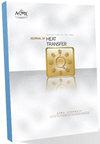Analytical Fractal Model for Effective Thermal Conductivity of Open-Cell Metallic Foams with Coated Hollow Ligaments
IF 2.8
4区 工程技术
Q2 ENGINEERING, MECHANICAL
引用次数: 0
Abstract
Coating the hollow ligaments of open-cell (fluid-through) metallic foams (MFs) fabricated via the sintering route with a thin layer of graphene can improve the effective thermal conductivity (ETC) of the foam without significantly increasing its flow resistance, potentially important for thermal storage applications. However, the Euclidean geometry cannot accurately depict the random distribution of pores within MFs. To this end, the present study aims to analyze how such thin coatings affect the ETC of MF by employing the fractal theory to depict the random distribution of its open pores. Subsequently, a cubic representative structure (RS) is chosen for self-similar pores in the fractal to establish a correlation between the geometric parameters of MF and its fractal dimension. Upon determining the thermal resistance provided a RS of the foam having coated hollow ligaments, its ETC is derived as a function of fractal dimension, dimensionless parameters of pore size, porosity, and thermal conductivity of relevant materials (e.g., ligaments, coatings, and filling medium). For validation, existing experimental data are used to compare with analytical predictions, with good agreement achieved. It is demonstrated that the ligament hollowness weakens the thermal conduction of MFs. In addition, when the coating has a thermal conductivity greater than that of ligament, the coating enhances the ability of the foam to conduct heat. Although the ligament hollowness and coating thickness are imperative factors affecting the ETC, the material makes of ligament and coating plays a decisive role in the ETC.包覆空心韧带开孔金属泡沫有效导热系数的解析分形模型
在通过烧结方法制备的开孔(流体通过)金属泡沫(MFs)的空心韧带上涂上一层薄薄的石墨烯,可以提高泡沫的有效导热性(ETC),而不会显著增加其流动阻力,这对储热应用具有潜在的重要意义。然而,欧几里得几何不能准确地描述孔隙在介质内的随机分布。为此,本研究旨在利用分形理论来描述其开孔的随机分布,分析这种薄涂层如何影响MF的ETC。随后,在分形中选取一个立方代表结构(RS)作为自相似孔隙的分形结构,建立其几何参数与其分形维数之间的相关性。在确定具有中空韧带涂层的泡沫的热阻RS后,其ETC被导出为分形维数、孔隙大小、孔隙率和相关材料(例如,韧带、涂层和填充介质)的导热系数的无量纲参数的函数。为了验证,使用现有的实验数据与分析预测进行比较,取得了很好的一致性。结果表明,韧带的空洞性减弱了MFs的热传导。此外,当涂层的导热系数大于韧带的导热系数时,涂层增强了泡沫的导热能力。虽然韧带中空度和涂层厚度是影响ETC的重要因素,但韧带和涂层的材质在ETC中起着决定性的作用。
本文章由计算机程序翻译,如有差异,请以英文原文为准。
求助全文
约1分钟内获得全文
求助全文
来源期刊
自引率
0.00%
发文量
182
审稿时长
4.7 months
期刊介绍:
Topical areas including, but not limited to: Biological heat and mass transfer; Combustion and reactive flows; Conduction; Electronic and photonic cooling; Evaporation, boiling, and condensation; Experimental techniques; Forced convection; Heat exchanger fundamentals; Heat transfer enhancement; Combined heat and mass transfer; Heat transfer in manufacturing; Jets, wakes, and impingement cooling; Melting and solidification; Microscale and nanoscale heat and mass transfer; Natural and mixed convection; Porous media; Radiative heat transfer; Thermal systems; Two-phase flow and heat transfer. Such topical areas may be seen in: Aerospace; The environment; Gas turbines; Biotechnology; Electronic and photonic processes and equipment; Energy systems, Fire and combustion, heat pipes, manufacturing and materials processing, low temperature and arctic region heat transfer; Refrigeration and air conditioning; Homeland security systems; Multi-phase processes; Microscale and nanoscale devices and processes.

 求助内容:
求助内容: 应助结果提醒方式:
应助结果提醒方式:


